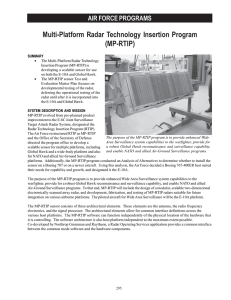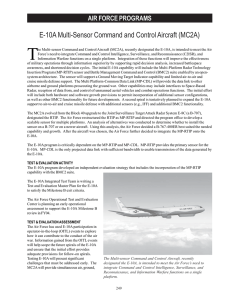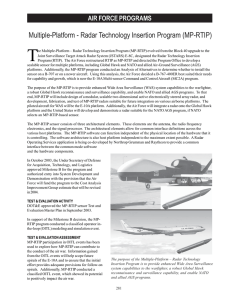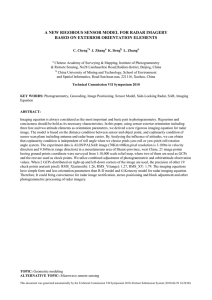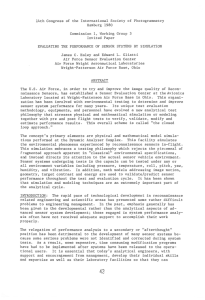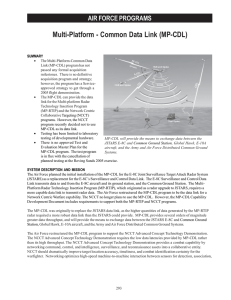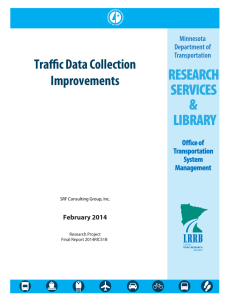E-10A Multi-Sensor Command and Control Aircraft AIR FORCE PROGRAMS
advertisement
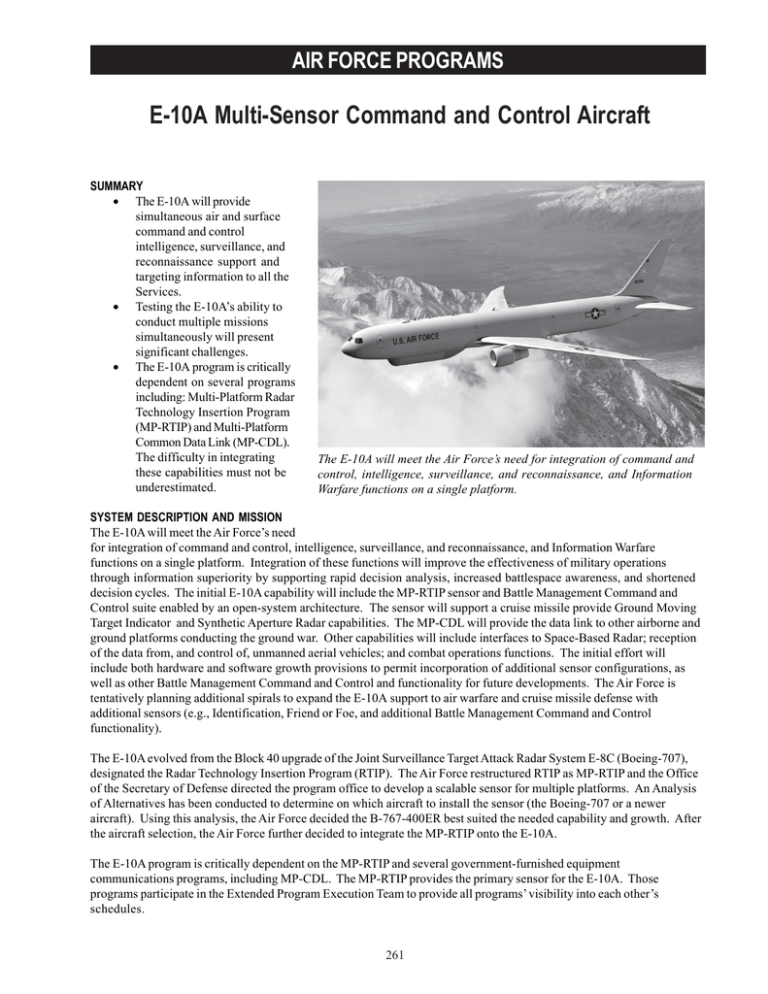
AIR FORCE PROGRAMS E-10A Multi-Sensor Command and Control Aircraft SUMMARY • The E-10A will provide simultaneous air and surface command and control intelligence, surveillance, and reconnaissance support and targeting information to all the Services. • Testing the E-10A’s ability to conduct multiple missions simultaneously will present significant challenges. • The E-10A program is critically dependent on several programs including: Multi-Platform Radar Technology Insertion Program (MP-RTIP) and Multi-Platform Common Data Link (MP-CDL). The difficulty in integrating these capabilities must not be underestimated. The E-10A will meet the Air Force’s need for integration of command and control, intelligence, surveillance, and reconnaissance, and Information Warfare functions on a single platform. SYSTEM DESCRIPTION AND MISSION The E-10A will meet the Air Force’s need for integration of command and control, intelligence, surveillance, and reconnaissance, and Information Warfare functions on a single platform. Integration of these functions will improve the effectiveness of military operations through information superiority by supporting rapid decision analysis, increased battlespace awareness, and shortened decision cycles. The initial E-10A capability will include the MP-RTIP sensor and Battle Management Command and Control suite enabled by an open-system architecture. The sensor will support a cruise missile provide Ground Moving Target Indicator and Synthetic Aperture Radar capabilities. The MP-CDL will provide the data link to other airborne and ground platforms conducting the ground war. Other capabilities will include interfaces to Space-Based Radar; reception of the data from, and control of, unmanned aerial vehicles; and combat operations functions. The initial effort will include both hardware and software growth provisions to permit incorporation of additional sensor configurations, as well as other Battle Management Command and Control and functionality for future developments. The Air Force is tentatively planning additional spirals to expand the E-10A support to air warfare and cruise missile defense with additional sensors (e.g., Identification, Friend or Foe, and additional Battle Management Command and Control functionality). The E-10A evolved from the Block 40 upgrade of the Joint Surveillance Target Attack Radar System E-8C (Boeing-707), designated the Radar Technology Insertion Program (RTIP). The Air Force restructured RTIP as MP-RTIP and the Office of the Secretary of Defense directed the program office to develop a scalable sensor for multiple platforms. An Analysis of Alternatives has been conducted to determine on which aircraft to install the sensor (the Boeing-707 or a newer aircraft). Using this analysis, the Air Force decided the B-767-400ER best suited the needed capability and growth. After the aircraft selection, the Air Force further decided to integrate the MP-RTIP onto the E-10A. The E-10A program is critically dependent on the MP-RTIP and several government-furnished equipment communications programs, including MP-CDL. The MP-RTIP provides the primary sensor for the E-10A. Those programs participate in the Extended Program Execution Team to provide all programs’ visibility into each other’s schedules. 261 AIR FORCE PROGRAMS TEST AND EVALUATION ACTIVITY The E-10A program is modifying the test strategy developed by the E-8D RTIP program to support the broader mission and requirements of E-10A. The E-10A Integrated Test Team is writing a Test and Evaluation Master Plan for the E-10A, including the MP-RTIP sensor. The Air Force is no longer planning to staff the Test and Evaluation Master Plan through the Army before submitting to the Office of the Secretary of Defense. The Air Force Operational Test and Evaluation Center is planning an Early Operational Assessment to support the E-10A Milestone B in FY05. There were no live fire test activities conducted in FY04. The Air Force is currently developing the Live Fire Test Alternative Plan. TEST AND EVALUATION ASSESSMENT Early attention towards understanding significant testing challenges is critical. The E-10A will provide simultaneous air and surface command and control intelligence, surveillance, and reconnaissance support and targeting information to all the Services. It will require a high degree of joint interoperability for both ground combat and air defense missions. Demonstrating the ability to support the simultaneous prosecution of the air and surface wars will require carefully planned field tests augmented by modeling and simulation. Development and testing will demand an unprecedented level of joint cooperation. There is risk associated with the integration of two Acquisition Category 1D programs (E-10A and MP-RTIP) and the MP-CDL. The E-10A is dependent on MP-RTIP to deliver its primary sensor. MP-RTIP is dependent on E-10A to provide a test platform for the sensor and the MP-CDL to serve as the pipeline for radar data to the users. The Air Force must closely coordinate the planned delivery of these three programs to ensure no part of the overall system has to wait for the delivery of the others. Due to the scope and the long lead-times required for these programs, such delays will significantly increase technical integration and costs. 262
